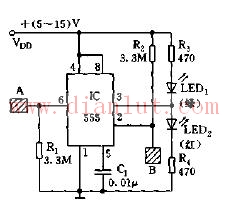As shown, the circuit consists of 555 core. It uses the 555 pins 6 and 2 respectively to connect the in-phase and inverting input terminals of the comparator A1 and the lower comparator A2 on the substrate, that is, to control its reset and set state to change its output state. When the metal piece A is touched, the 555 is reset, the LED, (green) is on, and the LED 1 (red) is off; when the metal piece 8 is touched, the LED 2 is on and the LED 1 is off. If the relay is switched, the power on/off control of the execution circuit can be realized.

Emphasis: Because of the market chaos and the cheating of bad dealers, most people simply don't understand USB 3.0 and USB 3.1. USB 3.1 Gen1 is USB 3.0. And USB 3.1 Gen2 is the real USB 3.1. The maximum transmission bandwidth of USB 2.0 is 480 Mbps (i.e. 60MB/s), USB 3.0 (i.e. USB 3.1 Gen1) is 5.0 Gbps (500MB/s), and USB 3.1 Gen 2 is 10.0 Gbps (although the nominal interface theoretical rate of USB 3.1 is 10Gbps), but it also retains some bandwidth to support other functions, so it has a good performance. The actual effective bandwidth is about 7.2 Gbps. USB 2.0 is a four-pin interface, and USB 3.0 and USB 3.1 are nine-pin interfaces.
USB 3.1 is the latest USB specification, which was initiated by big companies such as Intel. Compared with the existing USB technology, the new USB technology uses a more efficient data encoding system and provides more than twice the effective data throughput (USB IF Association). It is fully downward compatible with existing USB connectors and cables.
USB 3.1 is compatible with existing USB 3.0 software stacks and devices
USB3.1 LOGO
USB3.1 LOGO
Protocol, 5Gbps hubs and devices, USB 2.0 products.
Intel, which owns Thunderbolt technology, also welcomes the formation of the USB 3.1 standard. USB 3.1 contains most of the features of USB 3.0 [2]. USB 3.1, as the next generation of USB transmission specifications, is commonly referred to as "SuperSpeed+", which will replace USB 3.0 in the future. [3]
USB 3.1 C SMT FINISHED,DIP USB3.1 Plug,Vertical USB Connector,USB Type-c Receptacles Shell
ShenZhen Antenk Electronics Co,Ltd , https://www.atkconnectors.com